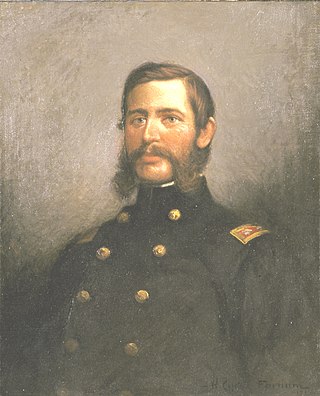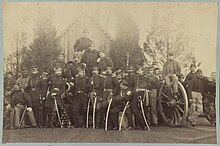
The 5th New York Infantry Regiment, also known as Duryée's Zouaves, was a volunteer infantry regiment of the Union Army during the American Civil War, led by Colonel Abram Duryée. Modeled, like other Union and Confederate infantry regiments, on the French Zouaves of Crimean War fame, its tactics and uniforms were different from those of the standard infantry.

The 2nd Wisconsin Infantry Regiment was an infantry regiment that served in the Union Army during the American Civil War. It spent most of the war as a member of the famous Iron Brigade of the Army of the Potomac. It suffered the largest number of casualties as a percentage of its total enlistment of any Union Army unit in the war.

The Eastern Iron Brigade, also known as the Iron Brigade of the East and First Iron Brigade, was a brigade of infantry, that served in the Union Army's Army of the Potomac, during the American Civil War. For much of its service, it was designated as the 1st Brigade, 1st Division, I Corps. Among its commanding officers were General John P. Hatch and General Walter Phelps Jr. Noted for its reliability in battle, the brigade developed a reputation which remained after it was disbanded late in the war, due to its annihilation from extremely high casualties.
The 258th Field Artillery Regiment or "Washington Greys" is a field artillery unit of the New York Army National Guard that traces its lineage from 1809 to present. Circa 1957–1966 it consisted of four battalions.

The 140th New York Infantry Regiment was a volunteer infantry regiment that was created on September 13, 1862, for the Union Army during the American Civil War. From January 1864 they wore a Zouave uniform.
William A. Harn commanded a New York artillery battery in the American Civil War.
1st New Hampshire Light Artillery was an artillery battery that served in the Union Army during the American Civil War.
Battery A, 1st Rhode Island Light Artillery Regiment was an artillery battery that served in the Union Army during the American Civil War.

Battery B, 1st Rhode Island Light Artillery Regiment was an artillery battery that served in the Union Army during the American Civil War.

Battery D, 1st Rhode Island Light Artillery Regiment was an artillery battery that served in the Union Army during the American Civil War.
The 82nd New York Infantry Regiment, the "Second Militia," "Second Regiment N. Y. S. Light Infantry," or "State Guards", was an infantry regiment of the Union Army during the American Civil War.

The 43rd New York Infantry Regiment was an infantry regiment of the Union Army during the American Civil War. The 43rd New York was mustered in on September 21, 1861, and mustered out June 27, 1865. It was recruited largely in the Albany and New York City areas, fought in many engagements and took heavy casualties.
The 4th New York Heavy Artillery Regiment, U.S. Volunteers was a heavy artillery regiment that served in the Union Army during the American Civil War. The regiment operated as both heavy artillery and infantry beginning in February 1862 while serving in the defenses of Washington, D.C. and continued in both capacities until the end of the war.

The 58th New York Infantry Regiment, also called the Polish Legion, was an infantry regiment of United States Volunteers in Union Army service during the American Civil War. The regiment was composed almost entirely of immigrant volunteers: Poles, Germans, Danes, Italians, Russians, and Frenchmen, most of whom were recruited at New York City in 1861.
Battery L, 1st New York Light Artillery was an artillery battery that served in the Union Army during the American Civil War.
The 3rd Independent Battery, New York Volunteer Light Artillery or New York Independent Light Artillery was an artillery battery that served in the Union Army during the American Civil War.
Battery C, 1st New York Light Artillery was an artillery battery that served in the Union Army during the American Civil War.
The 5th Independent Battery, New York Volunteer Light Artillery or 5th New York Independent Light Artillery was an artillery battery that served in the Union Army during the American Civil War.

Independent Battery F, Pennsylvania Light Artillery, also known as the "Pittsburg Battery", was an artillery battery that served in the Union Army during the American Civil War. Organized in December 1861, the unit first served in the Shenandoah Valley. Battery F fought at Hancock, Winchester, Sulphur Springs, Second Bull Run, Chantilly, and Antietam in 1862. The following year the unit fought at Chancellorsville, Gettysburg, the Bristoe Campaign, and Mine Run. In 1864–1865, Battery F fought at Morton's Ford and served in the garrisons of Washington, D.C. and Harper's Ferry, West Virginia before being mustered out in June 1865. One enlisted man from the battery won the Medal of Honor for heroic action at Gettysburg.

Marcus Peter Miller was a career officer in the United States Army. A Union Army veteran of the American Civil War and a U.S. Army veteran of the American Indian Wars, Spanish–American War, Philippine–American War, he served from 1858 to 1899, attained the rank of brigadier general, and was commended for gallantry during several Civil War battles, the Modoc War, Nez Perce War, and the Iloilo campaign of the Philippine–American War.









